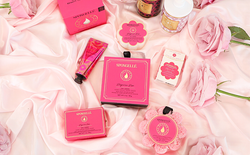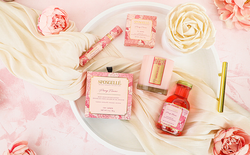When you want long, healthy hair, you’ll go to any lengths to get it. From hair extensions to growth serums, shampoos, and vitamin supplements, your options are endless. Some of these choices are quick fixes, while others may require precious time to reveal results.
Just how fast does hair grow, and how can you make it grow longer in record time? There isn’t a definite answer to which hair growth products work best because many factors are involved. Some of these factors include:
- Genetics
- Age
- Health
- Hormones
- Stress
- Hairstyles
Hair grows at an average rate of about six inches per year. This may not seem like much, but as your hair grows, it transitions through several stages within the growth process. The anagen, catagen, telogen, and exogen phases of hair growth determine your hair’s length and whether you experience hair thinning or hair loss.
Stages of Hair Growth
How quickly your hair grows depends significantly on the four growth stages. Each phase affects the next, and they all can be interrupted by outside physical and environmental stressors. The four phases of hair growth include:
- Anagen Phase: Hair growth occurs during this stage.
- Catagen Phase: The transitional phase between growth and resting.
- Telogen Phase: The resting/sleeping phase.
- Exogen Phase: The fallout stage. This occurs during the telogen phase. Old hair falls out and is replaced by new hair, transitioning back to the anagen growth phase.
How Can You Make Hair Grow Faster?
Achieving healthier, longer hair is possible if you remain consistent in your hair growth attempts. Whether you’ve chosen to use hair growth serum, vitamins, or other treatments, most methods will work if they’re used for an adequate amount of time. We’ve listed several actions you can take to encourage stronger hair growth without the use of rogaine or other products that contain chemicals such as minoxidil.
Use a Hair Growth Shampoo
Hair growth and hair-strengthening shampoos contain ingredients that nourish the scalp and strengthen the hair shaft. Some of these shampoos must be massaged into the hair and scalp and allowed to rest on the scalp. This allows time for the ingredients to penetrate the strands. Sulfate-free shampoo and balancing hair care products tend to be more gentle on hair.
These products help support the integrity of the hair strands, possibly supporting hair growth and strength retention. Remember to always use hair care products that are designed for your specific hair type. This will prevent unnecessary damage and dryness.
Use a Hair Growth Serum
Topical hair growth serum helps reduce hair thinning and increase the rate of hair growth. Some serums are available over the counter, while more potent treatments may be prescribed by a dermatologist. Concentrated ingredients work to penetrate the scalp and stimulate the hair follicles to begin the anagen growth phase. Ingredients may include all-natural or chemical substances.
Hair Growth Supplements
Nutrition plays a crucial role in hair health. It is important to consume fresh vegetables, fruits, nuts, lean meats, and whole grains. These foods contain essential nutrients that support healthy bodily functions, including hair growth. Perhaps you’re familiar with supplements that claim to assist in the hair growth process. These tablets usually contain the following nutrients:
- Omega 3 fatty acids and DHA: Deficiency in these may lead to hair thinning and hair loss.
- Iron: An iron deficiency may lead to hair loss, among other health problems.
- Zinc: Zinc deficiency may lead to dry hair and hair loss.
- Biotin: Biotin deficiency may lead to hair thinning.
- Vitamin A: Large amounts of vitamin A may cause hair loss.
- Vitamins B: Vitamin B deficiency may lead to hair loss and a slow growth rate.
- Vitamin C: Vitamin C deficiency may lead to dry hair and split ends.
- Vitamin D: Vitamin D deficiency may lead to irregular hair growth and hair shedding.
As with any supplement, always talk to your doctor before beginning any new vitamin regimen.
Scalp Stimulation
Massage your scalp to help stimulate blood circulation. Increased blood flow on and around the scalp encourages follicle stimulation and hair growth. When hair growth products are used in addition to scalp massage, growth and hair health results may increase.
Wear Loose Hair Styles
Loose hairstyles promote healthier hair because they reduce tension in the hair follicle. Tight ponytails, buns, and braids pull on the hair strands, causing traction alopecia. This type of hair loss occurs when hair is repeatedly pulled tight. Opt instead for wearing your hair down or in loose hairstyles.
Avoid Heated Hair Styling Tools
When used too frequently, heated hair tools negatively affect the hair’s cuticle. Heat styling causes split ends and dry strands. The following tips and hair care products will help you achieve healthier, longer, and stronger strands of hair:
- Heat protectant: This hair product protects your strands from the heated temperatures of hair styling tools. Think of it as sunscreen for your hair. Simply apply a heat protectant to your hair before using a hair dryer, curling iron, or flat iron to protect, smooth, and hydrate your strands.
- Avoid tight hairstyles: Loose hairstyles reduce the chance of experiencing traction alopecia (hair loss). Opt for wearing your hair down instead of pulling it into tight styles such as buns, braids, and ponytails. Hair extensions also affect hair growth by causing traction on hair follicles.
- Visit a professional: At-home hair coloring, bleaching, perming, and relaxers may leave your hair dry and damaged. Leave these chemical treatments to a hairstylist who can incorporate hair-healthy keratin bond builders into your processing service. Hair trims are another way to make your hair appear healthier. A simple trim every six to eight weeks ensures your locks look and feel healthier.
What Negatively Affects Hair Growth?
As we’ve learned, hair growth is negatively affected by many factors. Nutrition, vitamin deficiencies, hair care products, and how you style your hair affect hair growth. There are a few additional contributing factors that negatively affect hair growth.
Stress
We experience stress every day, and though it affects our mood, it also affects our hair. Hair thinning and hair loss result from high levels of stress. Chronic stress increases cortisol levels and prematurely forces hair follicles into the resting phase of the hair growth cycle. The resting hairs remain “asleep” until they eventually fall out, leaving you with a thinner mane.
Stress reduction techniques help to prevent high-stress levels that lead to hair thinning and hair loss. Try yoga, meditation, a bath with a luxurious body wash, or breathing exercises to help reduce stress levels.
Skipping Conditioner
The American Academy of Dermatology (AAD) recommends using conditioner after every shampoo. The AAD also says to protect your hair while swimming by wearing a swim cap and rinsing your hair immediately after swimming. Use a specially formulated swimmers shampoo that effectively removes chlorine and mineral buildup.
Follow with a deep conditioning treatment to replenish hydration and reduce breakage and split ends. These actions help reduce the amount of breakage and split ends associated with swimming pool chemicals.
Smoking
Smoking increases inflammation and may lead to androgenetic alopecia (male or female pattern baldness). Tobacco use causes damage to the hair follicle, resulting in hair thinning and hair loss. Smoking is an environmental factor that negatively affects hair and its growth. It also leads to other health conditions such as stroke, heart disease, lung disease, and high blood pressure.
To Sum It Up
Getting the longer, stronger hair you desire may seem impossible. Still, with a bit of action, you may be able to support longer hair lengths and reduce breakage. Scalp and hair health depend on proper nutrition, adequate vitamin supplementation, quality hair care products for your hair type, and reduced stress levels.
To encourage faster hair growth, simply maintain a healthy lifestyle and opt for hair care products designed for your hair type. Visit your doctor or dermatologist if you experience hair loss in patches, as this may be a sign of genetic inheritance or nutritional deficiencies. With a little love and effort, you’ll be on your way to healthier, longer, stronger hair in no time!
Sources:
What are the best foods for healthy hair growth? | Medical News Today
What are the best foods for healthy hair growth? | Medical News Today
10 hair care habits that can damage your hair | AAD
Androgenetic alopecia: MedlinePlus Genetics | Medline Plus
Role of Smoking in Androgenetic Alopecia: A Systematic Review - PMC | NCBI















